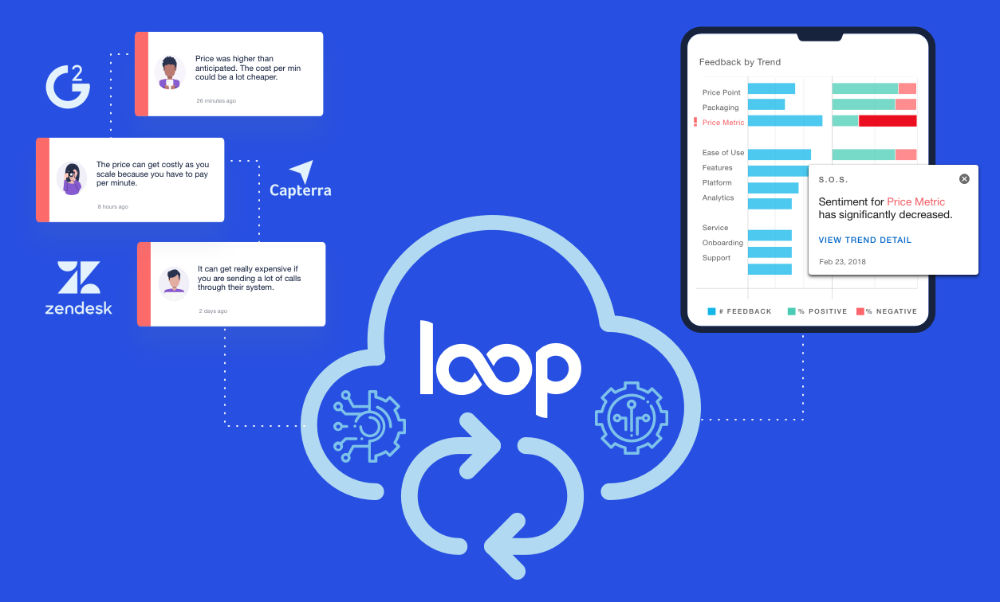Home » How to get buy-in and keep coworkers engaged in your Voice of the Customer program
How to get buy-in and keep coworkers engaged in your Voice of the Customer program

Lauren Culbertson
Co-founder and CEO, LoopVOC

Getting buy-in for any new program can be tough.
Getting buy-in for a new cross-functional program is tougher.
That’s what makes getting a Voice of the Customer program off the ground so challenging. VoC programs focus on driving company change based on customer feedback, and customer feedback comes from almost every department, whether it’s product management, marketing, sales, or customer success.
It’s critical to break down the silos to get internal buy-in from cross-functional stakeholders before starting a Voice of the Customer program. You will need internal alignment to not only ask for feedback in the right channels but to actually turn customer feedback into company-wide action. This means:
- Your product team will be able to build the feature requirements most tied to revenue and churn.
- Your marketing team will be able to use feedback themes to create stronger messaging and positioning.
- Your frontline teams will be able to set better expectations in the sales process and across the customer journey.
Getting alignment upfront will ensure all stakeholders are committed to sharing customer feedback data, regularly reviewing feedback trends to identify opportunities and threats, and using learnings to adjust functional strategies.
Here are several tips for getting stakeholders to buy-in to your Voice of the Customer program, and how you can keep them engaged once the work has started.
Start by clarifying what you need from your stakeholders.
To achieve cross-functional buy-in, you’ll first want to map out the stakeholders that will need to be involved in the program. This usually includes:
Once you’ve mapped out your stakeholders, you can crystalize your asks for their involvement. This includes why you need their buy-in and how they will be involved in your Voice of the Customer program.
For example, let’s take Customer Success.
You’ll likely need buy-in from Customer Success because they usually own sending out customer surveys like NPS and CSAT, which are valuable sources of feedback.
You need to get their buy-in to share their feedback data to understand insights like why customers are leaving and what opportunities you have to deliver more value to them.
You also need customer success to commit to making changes to adoption strategies based on what you learn in the VoC process. This includes:
- Making sure their teams are adequately trained
- Ensuring engagement is happening over the right channels
- Making information and help materials more accessible
- Creating tiered service levels based on customer segments
Now let’s take Product Management.
You’ll need buy-in from Product Management because they usually own product feedback channels that tell you where customers struggle in the product, and what features they are asking for.
You need to get their buy-in to share their feedback data, as well as their commitment to making changes to the product roadmap based on what you learn in the VoC process.
Clarifying your “asks” for stakeholders not only helps with initial buy-in, and can be used as reference throughout the program to ensure everyone is playing their part.
Show your stakeholders what’s in it for them.
Once you have your asks, the best way to get this buy-in for VoC is by centering stakeholders around the impact that it drives for the business.
At its core, your VoC program should drive revenue by creating more positive customers, who are more likely to renew and increase spend with your company. Leveraging a Voice of the Customer program to increase your percentage of positive customers, even marginally, can have a substantial effect on your overall revenue and the company’s bottom line.
By quantifying the business impact and return on investment (ROI) that a Voice of the Customer program can drive, you can focus your stakeholders on a common mission: to drive customer revenue. This helps to align your stakeholders around why their time and dollar investment in the program will help them and your company to achieve its goals.
If you need help calculating ROI, check out our step-by-step guide on how to measure the revenue impact and investment of your Voice of the Program.
Once you measure the ROI, you will continuously need to show your coworkers how their participation is paying off. If you launch a new product feature based on customer feedback, show your product management team how that action translated into additional revenue. This will reconfirm how their involvement in the VoC program helps them to achieve their goals, as well as the broader goals of the company.
Build and maintain trust to bring stakeholders along.
To get a seat at the table for a VoC program you need to have the authority and trust from other stakeholders to drive decisions beyond your functional role.
But what if you don’t yet have that authority or trust?
If you don’t have a seat at the table to drive decisions right now, that doesn’t mean you can’t get there. Build relationships, start small, demonstrate results, and ask for more.
For example, one Product Marketing Manager we work with was struggling to bring teams together around the customer. This individual was left out of conversations regarding product roadmap and customer success strategies.
She got permission to run a test initiative. She started by gathering data to influence roadmap decisions and hosting Voice of Customer meetings to ensure alignment around the customer.
In a few months, trust was built. She’s since helped change how roadmap decisions are made. And she’s now working with other teams across the business to influence strategy.
The impact of this initiative has gained the attention of her CEO and she is now meeting with the CEO regularly to talk about the insights she’s gathering and the biggest risks and opportunities she sees facing the business.
A Voice of the Customer program can’t exist in a silo.
The goal of a Voice of the Customer program is to use customer feedback to drive company changes that create more happy customers, who are more likely to renew. Getting upfront buy-in and maintaining cross-functional participation in your Voice of the Customer program is critical to driving lasting, company-wide change to better serve customer needs.
For more information on how to drive engagement in your Voice of the Customer program, check out our playbooks or feel free to schedule a chat with our team.




